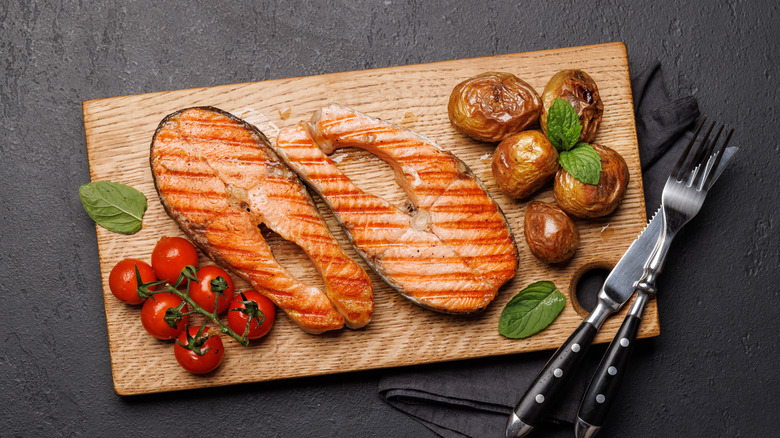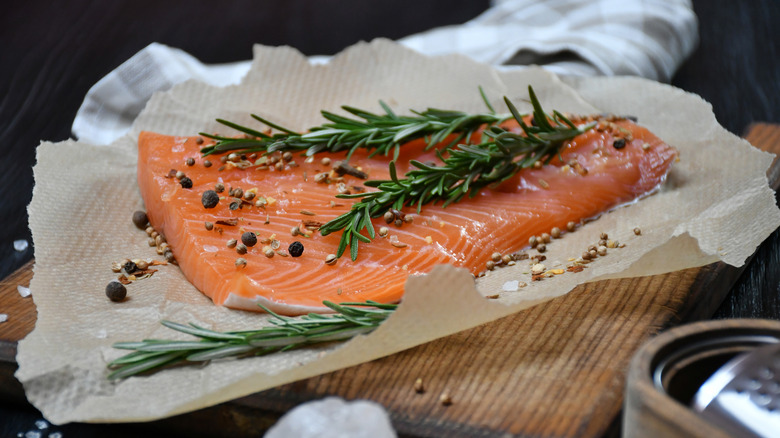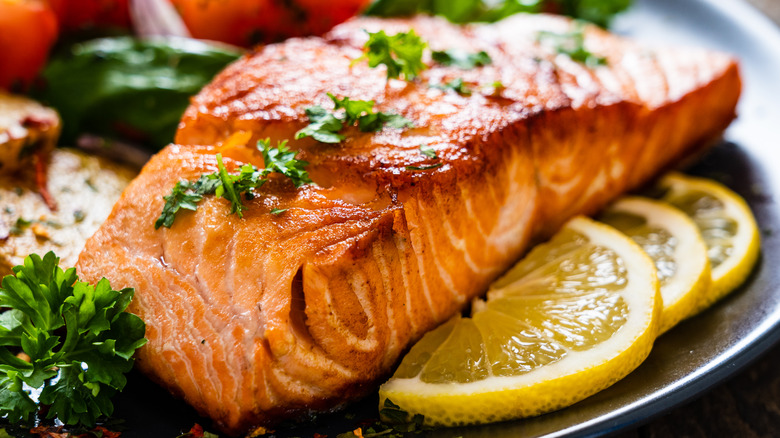A Chef's Advice On Making Restaurant-Worthy Grilled Salmon
It's often a struggle to recreate flavorful restaurant dishes at home. Whether it's figuring out how restaurants make such delicious baked potatoes or why restaurant steaks taste better, learning the trade secrets goes a long way to create restaurant-worthy dishes. The same holds true for grilled salmon. Getting that beautifully crisp skin and buttery texture, along with just the right seasoning, is the difference between an experience akin to dining out and just another piece of dry, flaky fish. So, Chowhound asked Taylor Hester, the Executive Chef at Roscioli NYC, for some professional guidance. His best advice for grilling great salmon comes down to two primary tactics. First, make certain you're using high-quality fish to begin with. Then, use the best grilling techniques to retain moisture in the fragile flesh as it cooks.
The year-old West Village location of Roscioli doesn't currently have salmon on the menu, but Hester is no stranger to the vagaries of the fish. He worked in Maine at the "fish-forward" Dennett's Wharf and at the Brooklyn restaurant Olmsted before that. In his current capacity at Roscioli, he's participating in City Harvest's BID 2024: CHTV! fundraiser on October 29, 2024. Guests will get to sample food and drink from some of the city's best chefs and bartenders, while the nonprofit raises money to continue rescuing surplus foods from grocery stores and restaurants for redistribution to food-insecure New Yorkers. While Hester may not be preparing grilled salmon at City Harvest's upcoming event, he still has tips for perfecting the dish.
Preparing grilled salmon the right way
When grilling salmon, always start with a high-quality piece of fresh fish. Grabbing frozen or discount-bin salmon puts you at a disadvantage. "Starting with wild-caught salmon will help make even a simple grilled salmon that much better," says Chef Taylor Hester. Aim for the freshest pieces you can reasonably afford at the grocery store, as they will hold together better on the grill and taste better once off of it. Many people swear the thick center cuts of salmon are best for grilling.
The next step is preparing the fish for the grill. Leave the skin on: Removing it is one of the big mistakes people make when cooking salmon. Not only does it help hold the fish together during grilling, but the charred, crisped-up skin itself is delicious. Second, season it, of course. You can do a simple salt, pepper, and oil seasoning (which some say is the best way to season salmon), or take it a step further. "Treat the fish ahead of time with a brine or dry-rub to enhance the flavor of the fish," says Hester. If you want to get elaborate (and why not), consider seasonings that will upgrade your salmon, such as dill or curry. A wet or dry brine for 15 minutes to a few hours (or even overnight) helps draw the albumin or "white ooze" out of the salmon, which some people don't like. Many people prefer wet brining fish, since it helps add moisture.
The side you should start with when grilling salmon
Finally, Chef Taylor Hester suggests starting your salmon skin-side down, a common tactic when cooking most fish — just make sure your grill is clean, hot, and oiled before proceeding. "Grilling skin-side down first can help protect the fish during the cooking process while retaining moisture," he says. You're accomplishing a few things with this move. First, the tough skin helps the flaky fish keep its form. Setting it on the grill (or pan) skin-side down means most of the cooking is done with the stronger skin insulating the flesh, yet still heating it. And when it's time to flip, the flesh side is only cooked for a couple of minutes, keeping it nice and tender. Plus, you get the benefit of beautifully crispy skin.
Of course, not everyone agrees with this tactic. Chowhound's Camryn Teder says there are chefs who buck conventional wisdom and swear grilling skin-clad salmon flesh-side down first is the right way to go. Salmon only starts flaking once it's finished cooking. So, if you put firm, raw salmon flesh on the grill and flip it to the skin-side before it's done, you're reducing the chance of flesh sticking to the grill. (Of course, oiling your grill beforehand can also help counteract this.) If the grill is hot enough, you're also going to get those wonderful sear marks that won't happen with only a minute or so of cooking the other way.


